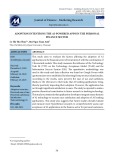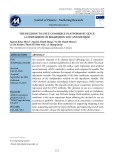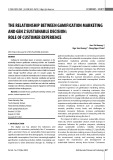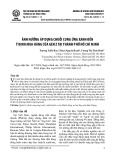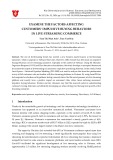
P-ISSN 1859-3585 E-ISSN 2615-9619 https://jst-haui.vn ECONOMICS - SOCIETY Vol. 60 - No. 11E (Nov 2024) HaUI Journal of Science and Technology
97
THE RELATIONSHIP BETWEEN GAMIFICATION MARKETING AND GEN Z SUSTAINABLE DECISION: ROLE OF CUSTOMER EXPERIENCE
Hoa Thi Hoang1,2, Ngo Van Quang3,*, Dang Ngoc Cham3 DOI: http://doi.org/10.57001/huih5804.2024.348 ABSTRACT
Clarifying the intermediate impact of consumer experiences on the
relationship between gamification marketing activities and Sustainable
Decisions within the scope of
research in the Hanoi area targeting Generation
Z (Gen Z). Utilizing basic theories of social presence and inheriting research
values from scientists and authors, the authors construct a high-
level research
model. Through SmartPLS4 software with 372 resear
ch samples, the
conclusion is drawn to clarify the intermediary role of consumer experiences.
The research results serve as both a theoretical contribution and practical
content for firms in the content marketing market. By recognizing the pivotal
influenc
e of consumer experiences, related firms can tailor their marketing
strategies more effectively, enhancing consumer engagement and fostering
sustainable decision-making practices. Keywords:
Sustainable decision, gamification marketing activities, social
presence, customer experience, Gen Z.
1Hunan University, China 2Sao Do University, Vietnam 3Hanoi University of Industry, Vietnam *Email: quangnv@haui.edu.com Received: 12/5/2024 Revised: 22/7/2024 Accepted: 28/11/2024 1. INTRODUCTION The digital era has altered the behaviors and preferences of consumers, particularly Gen Z consumers, with a prominent focus on sustainable choices garnering significant attention from this demographic. To encourage sustainable consumption, firms have increasingly applied gamification marketing activities (GMA), leveraging user experiences to drive behavioral changes [1]. Feelings of guilt and pride play crucial roles in convincing consumers of the efficacy of sustainable consumption choices. Indeed, gamification marketing activities evoke customer emotion, which can influence sustainable choices. Furthermore, [2] segmented consumer markets indicate that goal-oriented gamification strategies may effectively attract Gen Z consumer groups. Despite current research results, significant knowledge gaps persist in understanding the nuanced interactions among GMA, user experiences, and sustainable consumption choices among Gen Z consumers. Entertainment plays a pivotal role in enhancing the customer experience of gamification marketing activity. Entertainment is crucial in attracting customers, thus emphasizing the importance of marketing activities. GMA understood as the gamification of marketing, applies gaming elements to engage individual users [3, 4[, utilizing game elements in marketing strategies to create enjoyable experiences and positive interactions with customers. This includes employing elements such as competition, rewards, penalties, scores, levels, and challenges to stimulate consumer behavior, increase participation motivation, and generate interest in interacting with the brand [5], particularly among the Gen Z. The impact of GMA on consumer sustainable choices exists [6], where sustainable choices entail changes in consumer behavior for positive purposes, educating about sustainable activities, notably enhancing awareness of balanced decision-making [7]. Specifically, it involves the decision-making process of purchasing or consuming products and services that positively impact the environment, society, and economy, aiming to support the maintenance and development of sustainable balance among these factors. Consumers






















